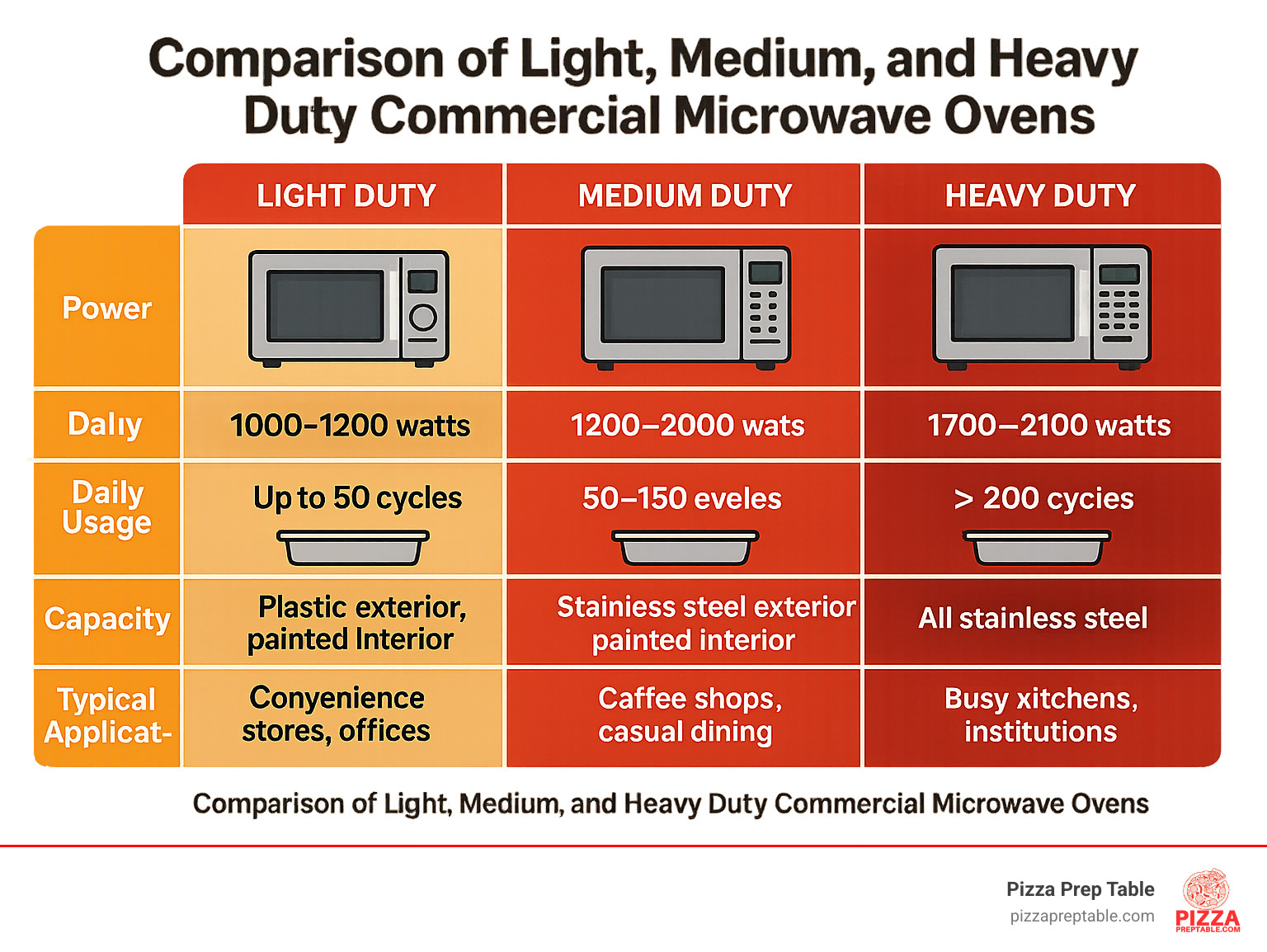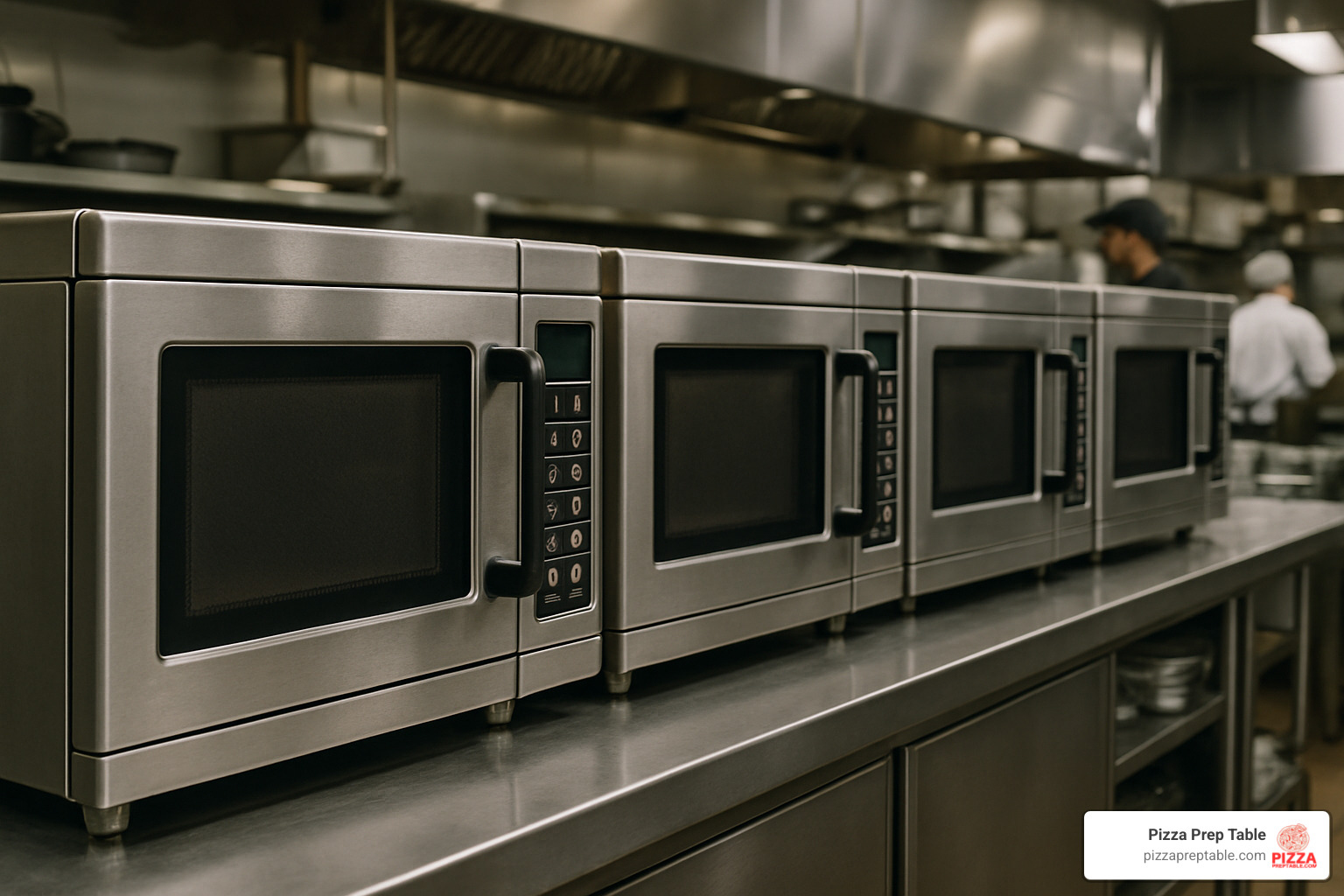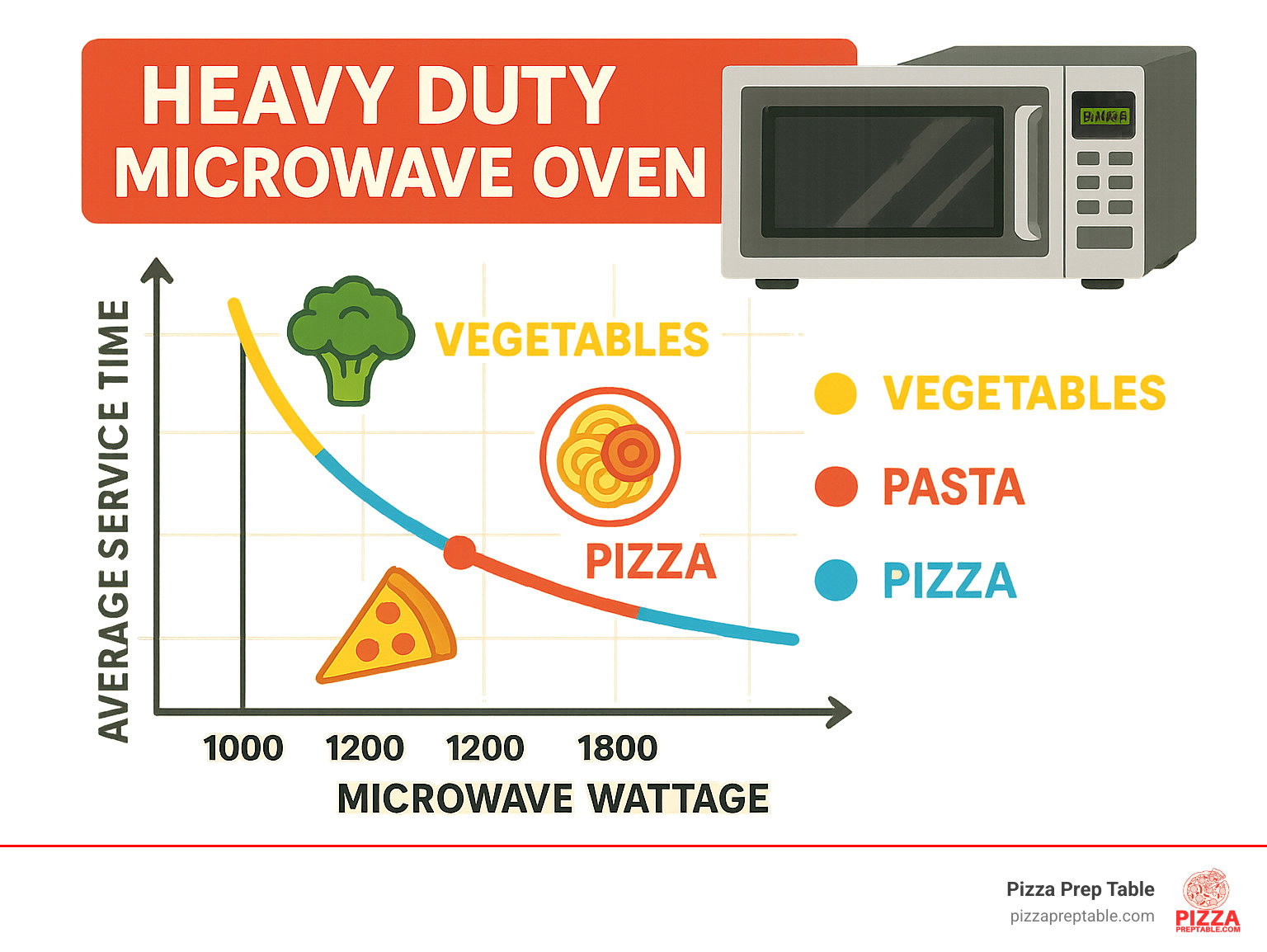
Restaurant Microwaves That Mean Business
Share
Power Up Your Kitchen: The Real Deal on Heavy Duty Microwave Ovens
Heavy duty microwave ovens are commercial-grade units specifically designed for high-volume foodservice operations. Unlike residential or light-duty models, they're built to handle over 200 cycles per day with consistent performance.
Quick Answer: What Makes a Microwave "Heavy Duty"?
- Power: 1700-2100 watts (vs. 700-1000W for home units)
- Construction: All stainless steel interior and exterior
- Capacity: Typically 0.6 cubic feet (fits half-size food pans)
- Programming: 90+ memory settings for consistent results
- Durability: Rated for 200+ heating cycles daily
- Price Range: $1,200-$2,500
Heavy duty commercial microwaves are workhorses that power through demanding foodservice environments where speed and reliability are non-negotiable. With significantly higher wattage (1700-2100W), they can reheat and cook foods in a fraction of the time of standard models, making them essential equipment in QSR chains, fast casual restaurants, and high-volume kitchens.
What sets these units apart isn't just raw power—it's their robust construction, programmable controls, and purpose-built design for continuous commercial use. The stainless steel construction inside and out ensures durability while making cleaning faster and more effective.
For busy kitchens where counter space is at a premium, many heavy duty models feature stackable designs. Their programmable memory settings (often 90 or more) allow kitchen staff to maintain consistency across multiple shifts and locations—simply press a button and walk away.
I'm Sean Kearney, and I've spent years evaluating and selling heavy duty microwave ovens for restaurants and food businesses, helping hundreds of operators select the right equipment to maximize their kitchen efficiency and throughput.

What Makes a Heavy Duty Microwave Oven "Heavy Duty"?
Let's cut through the marketing fluff and get real about what makes these kitchen powerhouses truly "heavy duty." This isn't just a fancy label – these machines earn their stripes through rigorous ANSI/NSF testing and are purpose-built for kitchens that never seem to slow down.
Think of a heavy duty microwave oven as the commercial truck of your kitchen fleet – while it might resemble its residential cousin from across the room, pop the hood and you'll find entirely different engineering underneath.
| Feature | Heavy Duty Commercial | Medium Duty Commercial | Light Duty/Residential |
|---|---|---|---|
| Power Output | 1700-2100W | 1000-1200W | 700-1000W |
| Daily Usage | 200+ cycles | 50-200 cycles | <50 cycles |
| Construction | All stainless steel | Stainless interior | Painted steel/plastic |
| Magnetrons | Often dual | Single | Single |
| Cavity Size | 0.6-0.7 cu ft | 0.8-1.2 cu ft | 0.7-2.2 cu ft |
| Programmable Memory | 90-360 settings | 10-20 settings | 0-10 settings |
| Typical Price | $1,200-2,500 | $600-1,200 | $100-500 |
| Warranty | 3 years commercial | 1-3 years commercial | 1 year residential |
| Typical Users | QSR chains, hospitals, cafeterias | Cafes, small restaurants | Break rooms, homes |
There's a good reason why major QSR chains invest in heavy duty microwave ovens – they need equipment that can handle the punishment of 12+ hour days without breaking a sweat. These units aren't just built to survive your kitchen; they're designed to become one of its most reliable team members.
Power & Capacity Basics
The heart of any heavy duty microwave oven is its impressive power output. Pumping out between 1700 and 2100 watts, these kitchen warriors cook food in a fraction of the time of standard models. But this isn't just about being fast – it's about keeping up when you've got a line of hungry customers stretching out the door.
Most heavy duty models give you plenty of flexibility with multiple power levels (usually around 15), so you can handle everything from gently warming delicate pastries to blasting a frozen sauce back to life in seconds. It's like having 15 different pieces of equipment in one footprint.
Here's what surprises many first-time buyers: despite their commercial muscle, most heavy duty microwave ovens feature a seemingly modest 0.6 cubic foot cavity. This isn't a limitation – it's actually smart design. The cavity perfectly fits a standard half-size food pan with cover or a 12-inch platter, focusing all that power exactly where it needs to go.
As one pizza shop owner told me with a laugh: "We replaced our old medium-duty unit that seemed to take forever with a heavy duty model. Now our baked potatoes are ready so fast, my staff had to create a new workflow just to keep up!"
Construction & Safety Must-Haves
Pick up a heavy duty microwave oven and you'll immediately feel the difference. These aren't flimsy plastic boxes – they're built like tanks with seam-welded stainless steel inside and out. This robust construction isn't just for show; it's what allows these machines to take a beating day after day without complaint.
The all-stainless design fights off corrosion, pitting and chipping while making cleaning a breeze (just wipe it down and you're back in business). It also meets health department requirements and significantly extends the lifespan of your investment. When you're running a busy kitchen, the last thing you need is equipment that gives up before you do.
Safety features aren't optional extras in these commercial workhorses – they're built into the DNA of every heavy duty microwave oven. Ergonomic grab-and-go handles let your team open doors quickly even during the chaos of rush hour. Multiple door-seal sensors and interlock systems ensure the unit won't operate unless properly closed.
The cool-touch exteriors mean no burned fingers even after hours of continuous use. Auto-shutoff features protect both your staff and your investment by powering down the unit if something's not right. These aren't just safety features – they're your insurance policy against costly downtime when you least can afford it.
As one chef put it: "In my kitchen, we don't have time for equipment that needs babysitting. Our heavy duty microwave oven just sits there quietly doing its job all day long – the ultimate team player."
Top Heavy Duty Microwave Ovens for 2024
Let's be honest – finding the right heavy duty microwave oven for your kitchen can feel overwhelming. After putting dozens of models through their paces and chatting with restaurant owners who use these workhorses daily, I've narrowed down the top performers that truly deliver on their promises. These are the models that stand tall when the kitchen gets hot and orders are flying in.

Panasonic NE-21521 – 2100 W "Pocket Rocket" heavy duty microwave oven
There's a reason kitchen staff lovingly call the Panasonic NE-21521 the "Pocket Rocket." This powerhouse packs a whopping 2100 watts into a surprisingly compact footprint, making it perfect for kitchens where space is at a premium but performance can't be compromised.
What makes this heavy duty microwave oven special is its thoughtful design. The 0.6 cubic foot cavity fits standard half-size pans perfectly, while 90 programmable memory settings ensure your staff can maintain consistency with just the push of a button. The dual independently controlled energy feeds aren't just marketing talk – they genuinely deliver more even cooking results, something you'll appreciate when every second counts during the lunch rush.
As one culinary instructor told me with a laugh, "My students have been trying to kill this thing for two years with constant abuse, and it still runs like new." At around $1,382, it hits that sweet spot of professional performance without breaking the bank.
Amana HDC 2100 – heavy duty microwave oven built for nonstop service
If reliability keeps you up at night, the Amana HDC 2100 might help you sleep better. Built specifically for operations that need 200+ heating cycles daily, this is the workhorse that QSR managers trust when failure isn't an option.
The standout feature has to be the Smart USB functionality. Being able to update your menu items via USB and the ACP remote Menu Management app is a game-changer for multi-location operations. No more sending technicians to reprogram units when you update your menu – just plug in and go.
I've spoken with several chain operators who swear by Amana's 24/7/365 ComServ support. As one manager put it, "When you're serving until 2 AM and something goes wrong, knowing there's always someone to call makes all the difference." The cleanable air filter is another thoughtful touch that extends the life of your investment without requiring professional service.
Sharp R-25JTF – dual magnetron workhorse
Sharp's R-25JTF takes a "belt and suspenders" approach to reliability with its dual magnetron system. This isn't just a backup – it's a design that spreads the workload between two power sources, extending the life of both while delivering more consistent results.
The TwinTouch control system is one of those "why didn't anyone think of this before?" features. By placing identical controls at both the top and bottom of the unit, Sharp ensures easy access whether the heavy duty microwave oven is positioned at eye level or below the counter in a stacked configuration. It's a small touch that makes a big difference in busy kitchens.
I especially appreciate the self-diagnostic system that identifies specific issues rather than just flashing a generic error code. Your maintenance team will thank you for this feature alone. Yes, it costs a bit more upfront, but when you factor in the potentially longer service life from the dual magnetrons, the math often works out in your favor.
Midea MRC 2100 – value powerhouse
Not every operation has premium equipment budgets, and that's where the Midea MRC 2100 shines. This heavy duty microwave oven delivers serious commercial performance at a more approachable price point without cutting corners on the essentials.
With 11 power levels instead of the standard 10, you get slightly finer control for delicate items. The variable fan speed control is particularly appreciated in open kitchen concepts where noise matters – crank it up during peak times for maximum cooling, then dial it back during quieter periods.
The menu locking function is worth its weight in gold if you've ever had well-meaning staff accidentally reprogram your carefully calibrated settings. While Midea might not have the name recognition of some competitors in the US, their commercial equipment has been steadily winning converts through solid performance and value.
Hybrid Speed Choice: Amana AXP22T combi (microwave+convection+infrared)
Sometimes you need more than just microwave power, and that's where the Amana AXP22T enters the conversation. This hybrid marvel combines microwave, convection, and infrared technologies to overcome the traditional limitations of microwave-only cooking.
The triple-threat heating approach means you can achieve results that were previously impossible – perfectly browned exteriors, crisp textures, and even cooking throughout. With a generous 1.38 cubic foot capacity and 360 programmable settings, it's like having multiple pieces of equipment in one footprint.
Yes, at $3,000+, it represents a significant investment compared to standard heavy duty microwave ovens. But for operations looking to expand their menu offerings without adding multiple pieces of equipment, the versatility can make financial sense. As one cafe owner told me, "It replaced three separate pieces of equipment and opened up counter space we desperately needed."
Key Buying, Installation & Ventilation Tips
So you've decided a heavy duty microwave oven is right for your kitchen—smart move! But before you click "buy now," let's talk about what it really takes to get one of these powerhouses up and running in your operation.

First things first: these aren't your home countertop units. Most heavy duty microwave ovens need serious electrical juice—typically 208/240V power on a dedicated 20-30 amp circuit. Those standard 120V outlets that power your phone charger? Not gonna cut it here. I can't tell you how many times I've heard from frantic restaurant owners who didn't check their electrical capacity before their shiny new microwave arrived.
A pizzeria owner in Boston once told me: "We installed our new heavy duty microwave without talking to an electrician first. During our first Friday night rush, we kept tripping the circuit breaker because it shared a line with our dough mixer. The emergency electrician visit cost us more than if we'd just planned properly from the start—not to mention the lost business!"
Ventilation is another area where commercial microwaves differ from conventional ovens. The good news? Most heavy duty microwave ovens don't require external ventilation hoods. The catch? They still need room to breathe—typically 2-3 inches on all sides. Those air intake and exhaust vents aren't just decorative, folks. Block them and you're basically cooking your microwave along with your food.
When it comes to placement, think beyond just "where it fits." These units weigh 70-80 pounds, so that wobbly prep table isn't going to work. You'll want a stable, level surface away from your heat-producing equipment like ranges and fryers. And don't forget about workflow—a perfectly good microwave placed in an awkward spot can slow down your entire operation.

Short on counter space? Many heavy duty microwave ovens are designed to stack, letting you double your capacity in the same footprint. Just be sure to use the manufacturer's stacking kit—this isn't the time for DIY innovation. Your insurance company (and fire marshal) will thank you.
At PizzaPrepTable.com, we always recommend consulting with a qualified electrician before purchasing commercial equipment, especially if your building is older. Many restaurants in historic districts of cities like New York or Chicago have electrical systems that need updating to handle modern kitchen demands.
Programmability & Workflow Gains
The real magic of a heavy duty microwave oven isn't just its raw power—it's the brains behind the brawn. Modern units offer incredible programmability that can transform your kitchen operations.
With 90-100 programmable memory settings, these workhorses let you create one-touch buttons for every menu item. Imagine training your newest team member in 30 seconds flat: "Need to heat the marinara? Hit button 12. Warming the garlic knots? That's button 27." No more guesswork, no more inconsistent results.
Multi-stage cooking is another game-changer. Your heavy duty microwave oven can automatically shift between power levels—starting with a defrost cycle, then moving to high heat, and finishing with a hold temperature. It's like having a sous chef dedicated to just one task.
For multi-unit operations, USB menu cloning is pure gold. Corporate can perfect recipes in the test kitchen, then push those exact settings to every location. A franchise owner in Dallas told me this feature alone saved them from countless customer complaints about inconsistency between locations.
The workflow benefits are tremendous: consistent food quality regardless of which staff member prepares it, "set and forget" efficiency that frees up hands for other tasks, dramatically simplified training for new employees, standardized preparation across all locations, and reduced food waste from precise cooking times.
For those looking to expand their cooking capabilities even further, check out our guide on Fast and Flavorful: Commercial Convection Microwave Ovens for Restaurants.
Safety & Compliance Checklist
Let's talk safety—because a busy kitchen is no place to cut corners. Before finalizing your heavy duty microwave oven purchase, make sure it ticks all these safety boxes:
Your microwave should carry proper certifications: a UL Listing confirms it meets electrical safety standards, NSF Certification ensures it meets public health requirements, and FCC Compliance verifies it won't interfere with other equipment. These aren't just fancy logos—they're your assurance that the equipment meets established safety protocols.
Look for safety features that protect both your equipment and your team: tempered glass windows that won't shatter, cool-touch exteriors that prevent accidental burns (especially important in tight kitchen quarters), multiple door interlock systems, control locks to prevent menu tampering, self-diagnostic alerts, and automatic shutoff for abnormal operation.
These features aren't just nice-to-haves—they're essential for health department compliance and could affect your insurance coverage. In busy kitchens across the Sun Belt, from Houston to Phoenix, those cool-touch exteriors are particularly important during summer months when kitchen temperatures soar.
Cost & Warranty Snapshot
Let's talk dollars and sense. A heavy duty microwave oven represents a significant investment, but one that typically pays for itself through improved efficiency and durability.
Price-wise, expect to invest between $1,200-2,500 depending on features and capacity. Entry-level heavy duty models start around $1,200-1,500, mid-range options run $1,500-2,000, and premium units with all the bells and whistles land in the $2,000-2,500 range. If you're looking at combo microwave systems with convection or infrared, budget $3,000-4,500.
The standard warranty for most heavy duty microwave ovens is 3 years parts and labor—significantly better than consumer models. Many manufacturers offer extended warranties for an additional 1-2 years. What's often overlooked but critically important is on-site service availability and parts inventory. A great warranty doesn't help much if the technician can't get parts for six weeks!
At PizzaPrepTable.com, we understand that cash flow is the lifeblood of restaurant operations. That's why we offer flexible financing options on all commercial equipment, including 12-36 month terms, competitive rates, and lease-to-own programs. Many of our customers in growing food scenes like Columbus, Denver, and Charlotte use these options to access premium equipment without depleting their operating capital.
When calculating ROI, think beyond the sticker price. That premium heavy duty microwave oven might cost $500 more upfront but last twice as long as the budget option—making it the smarter financial choice in the long run. Plus, the time savings during rush periods can translate directly to serving more customers and increasing revenue.
Maintaining & Troubleshooting Your Workhorse
Let's face it – your heavy duty microwave oven is like that reliable line cook who never calls in sick. But even the most dependable kitchen warriors need some TLC to keep performing at their best. With proper maintenance, these stainless steel powerhouses can serve your operation faithfully for years.
I've seen too many restaurants replace perfectly good equipment simply because they neglected basic upkeep. The good news? Maintaining these workhorses isn't complicated – it just requires consistency.
Your daily routine should include wiping down the interior with a damp cloth after service. Those little splatters might seem harmless, but when they bake on day after day, they'll eventually affect performance and food quality. Take 30 seconds to inspect the door seals for food debris – this simple check prevents energy leakage and ensures safety compliance. Finally, give those exterior surfaces a quick wipe with appropriate stainless cleaner to keep your kitchen looking professional.
Once a week, take your relationship with your heavy duty microwave oven to the next level. Remove and wash those air filters (they're usually easy to pop out), deep clean the interior with a non-caustic commercial cleaner, and check the door hinges and control panel. Think of it as your weekly date night with your most reliable kitchen partner.
Monthly maintenance might sound like overkill, but it's what separates the professionals from the amateurs. Inspect the power cord for any damage, check that the door aligns perfectly when closed, run any self-diagnostic tests your model offers, and if you've got a combo unit, descale those water systems.
"My Panasonic has outlasted three POS systems and two managers," a pizzeria owner in Chicago told me. "The secret? We clean it like it's brand new every single day."
For those operating in places like New Orleans or Miami where humidity is practically a food group, I recommend checking electrical components more frequently. Moisture is the silent enemy of electronics.
If you're using microwave technology in specialized research applications, our friends at Laboratory Microwave Ovens - Microwave Research Applications offer solutions beyond what we cover here.
Cleaning Hacks to Stretch Lifespan
After working with hundreds of restaurants, I've collected some genius maintenance shortcuts that won't void your warranty but will definitely extend your equipment's life.
Oven shield liners are possibly the best $20 you'll spend this year. These removable shields catch splatters before they hit the cavity walls, and you can pull them out for easy cleaning. Consider them cheap insurance against cooked-on messes.
Many operators swear by non-caustic cleaning sprays specifically formulated for commercial microwaves. Products like Amana's CL10 remove grease and food residue without damaging the cavity's surface. The harsh all-purpose cleaners in your janitor's closet? They might save you pennies but cost you hundreds in premature repairs.
The door gasket is the unsung hero of your heavy duty microwave oven. These rubber seals prevent energy leakage and trigger safety mechanisms when compromised. A quick preventative gasket check weekly can catch issues before they shut down your unit during the Saturday dinner rush.
For kitchens pushing their equipment to the limit, implementing scheduled cool-down periods between meal rushes gives magnetrons a chance to rest. Even 15 minutes can significantly extend component life.
One multi-unit operator in Dallas shared this gem: "We keep a spray bottle with equal parts water and white vinegar next to each microwave. Staff give the interior a quick spritz and wipe between rushes. No chemicals, no fumes, no transferred flavors between different menu items."
Quick Fixes Before Calling Service
When your heavy duty microwave oven decides to throw a tantrum, don't immediately reach for the phone. There are several simple fixes you can try that might save you a service call and keep your kitchen running smoothly.
If you're facing power issues, start with the obvious – is it plugged in securely? I can't tell you how many emergency service calls end with a sheepish "oh" when we find a loosened plug. Check your circuit breaker, test the outlet with another appliance, and make absolutely certain the door is completely closed (those safety interlocks are non-negotiable).
When your unit seems to be taking forever to heat food, dirty air filters are often the culprit. These little mesh screens prevent dust from entering the cooling system, but when clogged, they can cause overheating and reduced performance. Clean or replace them, verify you're running on the correct voltage, and ensure your unit has proper clearance on all sides for ventilation.
Control panel problems often resolve with a simple reset – unplug the unit for a full minute to clear any electronic hiccups. For newer models with digital controls, check if firmware updates are available. And yes, sometimes the solution is as simple as deactivating an accidentally engaged control lock.
Unusual noises warrant investigation, but don't panic just yet. Check for obstructions in the turntable or stirrer, make sure your microwave is sitting level, and verify you're not using oversized cookware that might be catching on the cavity walls.
Heavy duty microwave ovens contain components that carry serious voltage. Never attempt to disassemble the unit or access internal parts – that's a job for certified technicians. Your fingers (and your insurance company) will thank you.
A kitchen manager in Boston summed it up perfectly: "These machines are workhorses, not unicorns. They don't need magic – just common sense maintenance and respect for what they do for us every day."
Frequently Asked Questions about Heavy Duty Microwave Ovens
How many watts qualify a unit as a heavy duty microwave oven?
When it comes to power, a true heavy duty microwave oven packs a serious punch—typically between 1700 and 2100 watts. This is a world away from what you'd find in your home kitchen (usually 700-1200W) or even light commercial models hovering around 1000W.
This extra muscle isn't just for show. Those additional watts translate directly into faster heating times and the stamina to handle back-to-back-to-back use during your busiest rushes. When the tickets are flying and customers are waiting, that power difference becomes incredibly apparent.
I've seen some manufacturers try to market their 1200-1500W units as "heavy duty," but let's be honest—those fall squarely in the medium-duty category. If you're running a busy QSR, cafeteria, or restaurant that sees serious volume, don't settle for anything less than 1700W. Your staff will thank you during the lunch rush!
Remember though, raw power isn't everything. A true heavy duty microwave oven also features commercial-grade construction, higher duty cycle ratings, and components designed for constant use. It's the complete package that makes these workhorses worth the investment.
Do heavy duty models need external ventilation hoods?
Good news for your budget and installation plans—heavy duty microwave ovens don't require external ventilation hoods like your conventional ovens or fryers do. They come with clever self-contained cooling systems that circulate air through the unit and push it out through built-in vents.
That said, they do need a little breathing room:
- Give them about 2-3 inches of clearance on all sides
- Keep those air intake and exhaust vents completely clear
- Clean the air filters regularly (your manual will tell you how often)
- Keep them away from heat sources that could cause them to overheat
This ventilation independence is a huge plus, especially if you're operating in locations where installing hood systems would be a nightmare—think front-of-house areas, satellite kitchens, or historic buildings with strict ventilation restrictions.
Many of our customers in cities like San Francisco, Seattle, and Boston with their notoriously strict ventilation codes absolutely love this feature. It gives them cooking flexibility without triggering those expensive hood installations that can easily run into the tens of thousands.
Can I stack two heavy duty microwave ovens safely?
Yes, you absolutely can stack these powerhouses—in fact, most heavy duty microwave ovens are designed with stacking in mind! But before you start building your microwave tower, keep a few important things in mind:
Always use the manufacturer's approved stacking kit. This isn't just an upsell—these kits ensure proper alignment and ventilation between units. That $50-100 kit is cheap insurance against a $2,000+ equipment failure.
Make sure your counter or stand can handle the weight. Two commercial microwaves typically weigh between 140-160 pounds combined. That's like having a grown adult sitting on your prep table!
Even in a stack, both units need proper clearance for ventilation. Heat is the enemy of electronics, and trapped heat is even worse.
Check that your electrical system can handle both units running at full power simultaneously. This might mean dedicated circuits depending on your setup.
I love how some manufacturers have gotten smart with their "twin touch" controls—putting identical control panels at both the top and bottom of the unit. This means your shortest and tallest staff members can both operate the microwaves comfortably, no matter which position they're in.
For kitchens in space-crunched cities like New York, Philadelphia, or San Francisco, stacking compatible models essentially doubles your output capacity without eating up another precious inch of counter space—something that's worth its weight in gold when every square foot costs a small fortune in rent!
Conclusion
The right heavy duty microwave oven isn't just another appliance in your kitchen—it's a game-changing workhorse that can transform your operation's efficiency. When you invest in commercial-grade equipment built for continuous use, you're investing in speed, consistency, and reliability.

I've seen how the right microwave can make or break a busy service period. That moment when orders are flooding in and your equipment keeps pace without missing a beat? That's the peace of mind a quality heavy duty microwave oven delivers.
When you're ready to select your kitchen's new best friend, remember the essentials: match the power level to your volume needs (those 1700-2100W models aren't just showing off—they're built for serious output), consider programmable memory settings to maintain consistency across shifts, and always verify your electrical setup before making a purchase. Trust me, there's nothing worse than unboxing your shiny new equipment only to find your wiring can't handle it!
Don't overlook proper installation with adequate clearance around all sides. Your new heavy duty microwave oven needs to breathe, just like your kitchen staff during a Saturday night rush. And speaking of staff—take the time to train them properly on usage and cleaning procedures. A little TLC goes a long way toward extending your equipment's lifespan.
Here at PizzaPrepTable.com, we've helped thousands of restaurant operators across the country find their perfect kitchen match. From busy Chicago pizzerias slinging deep dish to trendy Atlanta fast-casual spots, we understand that every kitchen has its own unique rhythm and requirements.
Looking to optimize your cold storage alongside your cooking equipment? Our guide on Keep Cool and Carry On: The Ultimate Commercial Fridge Freezer Combo Guide is packed with practical advice to keep your ingredients fresh and your operations smooth.
Ready to explore more professional kitchen equipment that can take your operation to the next level? Visit our blog at https://pizzapreptable.com/blogs/pizza where we share expert advice, buying guides, and maintenance tips drawn from real-world experience.
A quality heavy duty microwave oven quickly pays for itself through improved efficiency and consistent food quality. Choose wisely, maintain diligently, and your commercial microwave will become the reliable partner your kitchen deserves—working hard behind the scenes while you take all the credit for those perfectly heated dishes flying out to happy customers.
